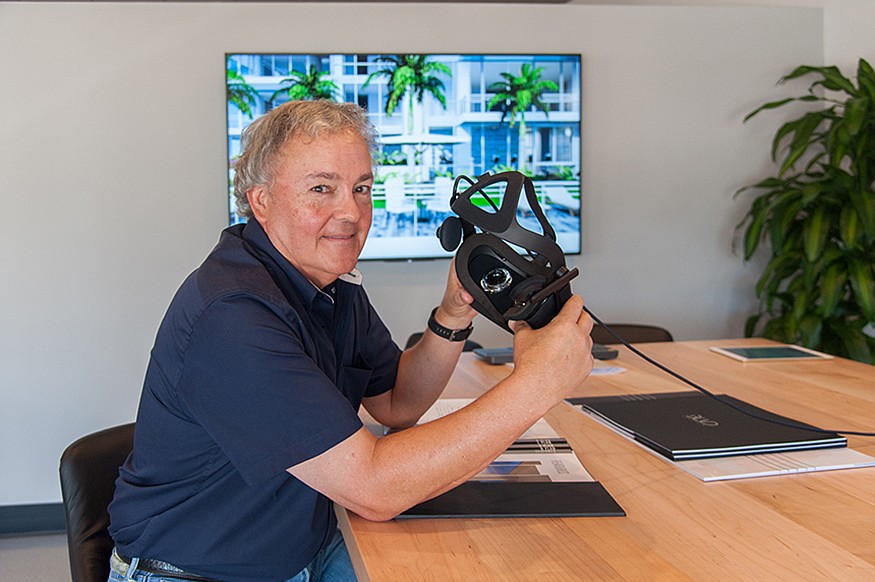- November 24, 2024
-
-
Loading

Loading

For its latest condominium project, BLVD Sarasota, Core Development Inc. developed a glossy, four-color sales brochure that has become de rigueur to entice luxury residential buyers.
But Core's marketing of the 49-unit project just outside downtown Sarasota didn't stop there. In addition to the print material, the company hired Imerza Origin Sarasota to develop a virtual reality presentation to showcase the 18-story tower, which is expected to commence construction in the coming weeks.
Controlled by an iPad and presented on a series of big-screen televisions and through a virtual reality headset, potential buyers visiting Core's sales center just north of downtown can view a three-dimensional representation of their future home — complete with images of both their furniture and the nearby Sarasota Bay.
“It's changed the whole way we're going about selling condos,” says Core President Kevin Daves.
Using drone video footage stitched together with actual photographs of nearby landmarks, BLVD Sarasota buyers can “see” the project's 18th-floor pool desk, the amenity level and even the way the sunlight dapples off the 800 feet of terrace space some units feature.
Perhaps best of all, with a few clicks viewers can change a unit's flooring, wall coloring, cabinets, appliances and so forth. Like drone photography before it, virtual and augmented reality is sweeping the commercial real estate industry and changing the way space is designed, built and marketed.
In addition to developers like Core, architects are employing virtual reality to render visions, general contractors are using it to troubleshoot and better communicate with owners, and interior designers are finding it a valuable tool to help customers make selections.
“It's the most important thing I am working on at present,” Colliers International Florida Executive Chairman Lee Arnold told a panel last year at the International Council of Shopping Centers' annual Orlando confab.
“You can plan how an entire physical space will look,” Arnold says of virtual reality.
For architects and contractors alike, augmented reality programs are eliminating time and expense, and allowing troubleshooting to take place before problems surface at a job site.
“It's a way for us to connect the dots,” Chris Mayer, chief innovation officer at Suffolk Construction Co., one of the Gulf Coast's largest commercial builders, says of augmented reality.
“With a virtual digital model, you can layer in changes in design,” adds Mayer, a former media consultant and publisher of the Boston Globe newspaper. “It's changing the way you communicate during the planning phase, and helps the client understand better potential complexities of the building process.”
To better harness the capabilities of virtual reality, Suffolk has developed a series of “Smart Labs” in regional offices, including in Tampa, Miami, New York, Boston and San Francisco.
Each lab contains a series of touch-capable computer monitors, 55-inch-screen televisions and a 14-by-14-foot virtual reality “cave” that sifts through real-time data collected from Suffolk construction sites.
“We're hoping to use them to reduce time, and thereby reduce costs, primarily so we don't have to make what can be costly changes out in the field on a job site,” Mayer notes.
And it's not just construction sites and sales centers where virtual reality is gaining ground. Commercial real estate sectors such as retail are embracing the technology to eliminate overhead and provide customers another resource to examine goods ahead of purchase.
Sonia Schechter is chief marketing officer for Marxent Labs, a St. Petersburg-based tech firm that has developed virtual reality programs for furniture and other retailers.
“Virtual reality is what the future of shopping and leased retail space will look like,” says Schechter. “With retail mash-ups occurring more frequently, this technology is one way you can put a Kohl's store inside a Dunkin' Donuts. And the reality is, a lot of retailers are already using many aspects of (computer-generated imaging) and 3-D products as sales tools.”
Schechter and others say that by 2022, virtual reality will be commonplace, both in stores and out.
“Today, generationally, there are a lot of people who wouldn't think of buying, say, furniture without going into a physical store,” she says. “But millennials and Generation Xers are different. I think in five years, we'll use virtual reality the way we use our phones today.”
Arnold, too, sees technological advancements that will make virtual and augmented reality more accessible for every facet of the commercial real estate industry.
“More and more companies already realize that you can't just post pictures on a website to properly market anymore,” he says. “I think eventually VR and AR will be so commonplace that there will be contact lenses that interact with your phone.”
Back at BLVD Sarasota, the use of virtual reality seems to be working. Of the planned tower's 49 units, only about half remain uncommitted — despite only a few months of marketing and price points ranging from $1.7 million to $6.4 million.
“People are so acclimated to TV nowadays, so this is a natural extension of that,” Daves says. “You can really see what a unit will look like, what it will feel like. A lot of people don't understand how to read floor plans, and with this, you don't have to.”